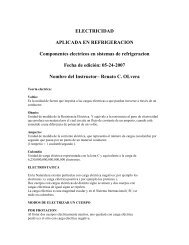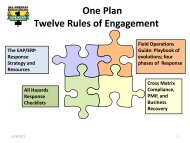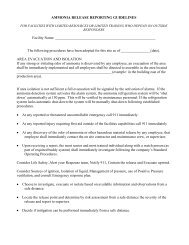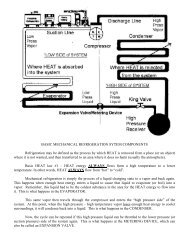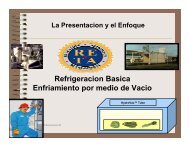Awareness Training Goals - Salinas Valley Ammonia Safety Day
Awareness Training Goals - Salinas Valley Ammonia Safety Day
Awareness Training Goals - Salinas Valley Ammonia Safety Day
Create successful ePaper yourself
Turn your PDF publications into a flip-book with our unique Google optimized e-Paper software.
<strong>Ammonia</strong> <strong>Safety</strong> <strong>Day</strong><br />
Summary Reminders for Emergency Response:<br />
• Communicate with facility operations Facility Emergency Coordinator to establish if the problem is<br />
“incidental” or if an actual emergency exists – note the location, nature, and timing of the release.<br />
Take a digital picture if safe to do so.<br />
• Monitor incident conditions and follow the ERP and Evacuation or Shelter-in-Place policy.<br />
• Establish a <strong>Safety</strong> Plan with zones and controls for the Hot Zone and make sure that proper PPE is<br />
being worn and the buddy system is enforced in the Hot Zone. Continue monitoring the atmosphere, if<br />
levels exceed the ERP standard you must exit the room.<br />
• Reference the Emergency Response Cards and Emergency Response Plan and develop a written<br />
Incident Action Plan and <strong>Safety</strong> Plan. Consider a downwind/downstream and control/containment plan<br />
of action.<br />
• Always use the buddy system. Have a backup entry team ready before entering the room and notify<br />
the Incident Commander when accomplishing the IAP objectives. Use “one in one out” for incidental<br />
control; “two in two out” is recommended for emergency response entry.<br />
Evacuation/Shelter in Place: Evacuated personnel will move laterally and upwind to pre-arranged<br />
assembly points, if possible, as soon as possible as guided by the Facility Emergency Coordinator and<br />
those he/she assigns to coordinate the evacuation. People located in the office and warehouse should<br />
evacuate and assemble at the designated evacuation meeting points. Wind direction and the actual location<br />
of the ammonia release will determine the best location of the evacuation gathering point. Once<br />
assembled, verify the head count and make sure that all employees, trucker drivers, visitors, and<br />
customers are accounted for. Personnel will remain at this location until released by the Plant Manager,<br />
Foreman or Lead Supervisor. Do not evacuate through a gaseous cloud or aerosol of ammonia; retreat to a<br />
shelter location where the doors and windows can be closed and the heating, ventilation and air<br />
conditioning systems can be shut down. Stay in “shelter in place” mode until contacted by the incident<br />
commander or when instructed to move out by evacuation coordinators. Stay tuned to the local emergency<br />
broadcast system on the radio.<br />
Regulator Notification: If the leak has been identified as being an RQ (Reportable Quantity 100 pounds<br />
of ammonia within 24 hours), report to your NRC (National Response Center) within 15 minutes of<br />
discovering the release (unless you are conducting life-critical response protocols). Local and State<br />
notifications are also required as listed in the State and Local emergency response plans. Most local and<br />
state regulators require a more immediate notification than the NRC guidelines. Your ERP should define<br />
the notification requirements more specifically.<br />
Incident Command System: During an ammonia emergency, the Facility Emergency Coordinator will<br />
assume initial control of the incident and implement the Incident Command System (ICS); the first public<br />
safety officer on the scene will assume the Incident Commander role (as determined in your Emergency<br />
Response Plan) and will oversee on-site and off-site emergency concerns. The response strategy and<br />
tactics will be implemented by using an incident action plan and safety plan. Command position<br />
descriptions and ICS approved response forms are located at the end of this document.<br />
Emergency Incident Information: The Facility Emergency Coordinator and Incident Commander will<br />
develop criteria regarding the information to be released about the status of the incident. Priority will be<br />
placed on releasing information that facilitates an effective response to and recovery from the incident,<br />
including concerns for those who are in shelter-in-place mode or potentially in harm’s way. The facilityspecific<br />
information should be held in confidence and used only to improve future operations. Those<br />
releasing information must be clear, honest, and straightforward in their communications on experiences<br />
that occurred during the incident. Details and suppositions regarding specific actions by those involved<br />
©ASTI – www.ammonia-safety.com – August 2008 25




